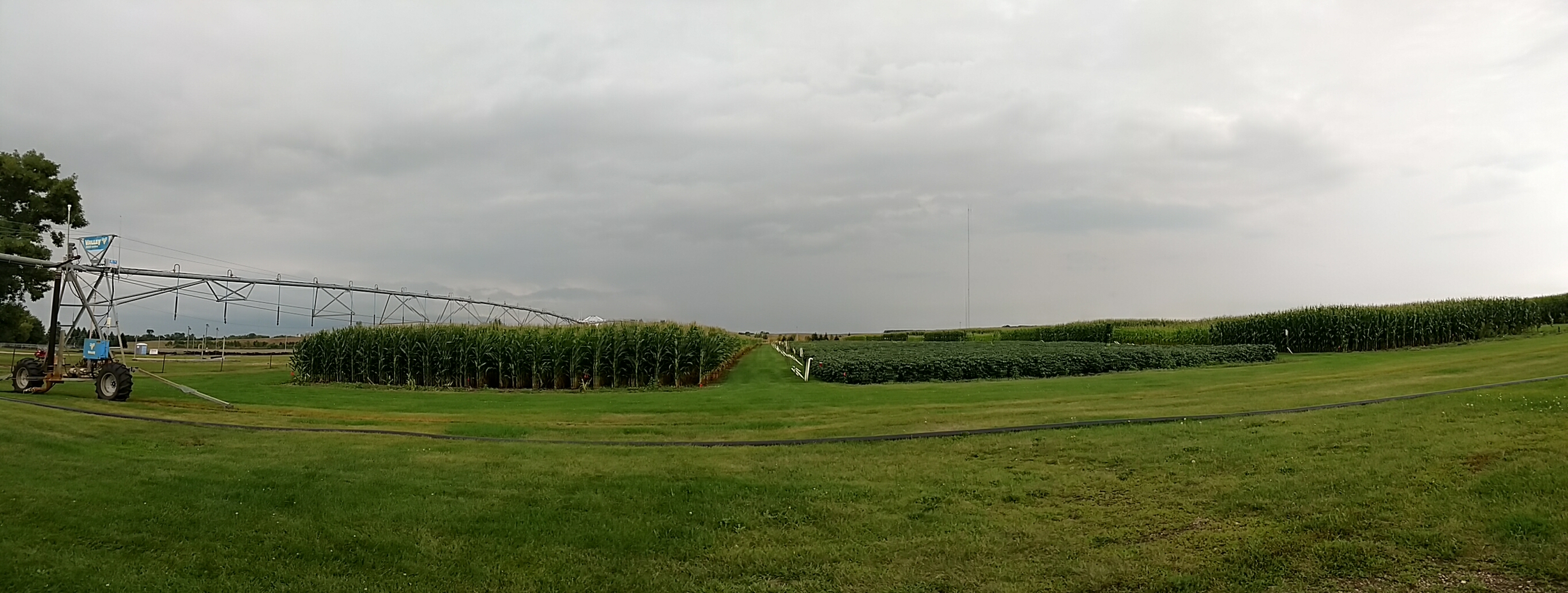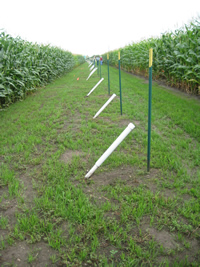 The MDA is working with partners at the Rosholt Research Farm near Westport, Minnesota to develop guidance and outreach on irrigation and nitrogen best management practices and the associated water quality impacts on irrigated, sandy soils.
The MDA is working with partners at the Rosholt Research Farm near Westport, Minnesota to develop guidance and outreach on irrigation and nitrogen best management practices and the associated water quality impacts on irrigated, sandy soils.
Current Research

The Rosholt Research Farm is located in Pope County near Westport, Minnesota and is approximately 40 acres in size. The farm's sandy soil and need for supplemental irrigation typifies the challenges that many producers face on the outwash sands of west-central and central Minnesota. An agricultural weather station was installed at the farm in 2012 as part of the Central Minnesota Agricultural Weather Network. The weather station was upgraded in 2019 with sensors for collecting additional soil moisture and temperature data and air temperature inversion information.
The Rosholt Farm is dedicated to agricultural research and education that addresses regional issues and agricultural practices that are typical in the area. Researchers address challenges that producers may face in the Central Sands region of Minnesota. Data collection started in 2011 and the work has since been expanded to several additional research projects.
Visit the Pope County SWCD's website for additional information on the Rosholt Research Farm.
1. Nitrogen, Cover Crop, and Water Quality Research
GOAL: To evaluate crop yield and water quality impacts of nitrogen management, cover crops and living mulches in irrigated corn and soybean.
The study evaluates the impact of nitrogen fertilizer management and a living mulch (kura clover), cover crop (winter rye) or no cover crop on nitrate leaching and yield for irrigated row crops.
PROJECT OVERVIEW:
- Rosholt Farm Nitrogen and Water Quality Research Fact Sheet (PDF)
- Fabian Fernanez, lead researcher of this study, shares more about this project in an interview with the Minnesota Crop News. Nitrogen study looks at two cover crops' potential to reduce nitrate leaching
RESULTS:
2. Variable Irrigation and Nitrogen Study A
GOAL: To optimize nitrogen rate and irrigation water management and to quantify their water quality and crop yield impacts.
The study evaluates the interaction between nitrogen rate and irrigation water management to determine water quality and grain yield impacts, optimum nitrogen rate, and water use efficiency. The study will also evaluate methods for in-season remote sensing-based water and nitrogen diagnosis.
PROJECT OVERVIEW:
Completed Research
Evaluation of four irrigation scheduling methods
GOAL: To identify and develop irrigation strategies that increase crop water use efficiency and reduce nitrate leaching without impacting crop yield.
The study evaluates four different strategies for agricultural water management, will develop an easy-to-use, simple and inexpensive tool for irrigation management based on soil matric potential and will promote the best irrigation management scheduler through outreach and education events
This project was funded through the Clean Water Research Program, to learn more please visit the project web page.
Reduced Irrigation Study
 GOAL: To improve irrigation water use efficiency by better understanding the interaction of water requirements of corn and plant population.
GOAL: To improve irrigation water use efficiency by better understanding the interaction of water requirements of corn and plant population.
The study evaluated the grain yield impact and corn rooting depth when reducing the frequency of irrigation. The study will also determined the role of reduced plant population under reduced irrigation frequency to optimize grain productivity.
Rosholt Farm Reduced Irrigation Study Fact Sheet (PDF)
Nitrogen Fertilizer Rate Recommendations
GOAL: To develop nitrogen fertilizer application rate recommendations for corn on irrigated sandy soils
The research that led to the University of Minnesota's 2015 nitrogen rate recommendations for corn on irrigated sandy soils was completed at the Rosholt Farm in conjunction with a project near Hastings, Minnesota in Dakota County during the 2011-2015 cropping seasons. This research was a major step forward towards improved nitrogen management based on nitrogen rate, yield and potential leaching losses associated with the nitrogen treatments, allowing for new best management practice development that keeps pace with the yield potential of new farm technology.
Fertilizing Corn Grown on Irrigated Sandy Soils (PDF)
Understanding Nitrate
Nitrate-nitrogen is a water soluble compound made up of nitrogen and oxygen. It can occur naturally in groundwater at low levels. Human activities such as sewage disposal, livestock production, and crop fertilization can elevate the level of nitrate in groundwater. The health risk limit (HRL) for nitrate is 10 ppm; above this level nitrate can have negative effects on human health, specifically infants under the age of six months. Nitrate has been found above the HRL in Minnesota groundwater (specifically drinking water), mainly in areas where well construction or surface geology (type of bedrock or soil) allows for rapid movement of nitrate from the surface down to groundwater resources.
Partners
![]()




